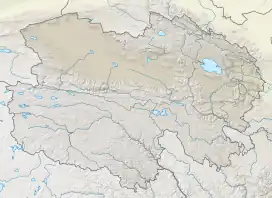North Hulsan Lake
North or Bei Hulsan Lake, also known by other names, is a lake northeast of Golmud in Dulan County, Haixi Prefecture, Qinghai Province, China. A part of the Qarhan Playa, it is filled from the east by the Qaidam River. Like the other lakes of the surrounding Qaidam Basin, it is extremely saline.
| North Hulsan Lake | |
|---|---|
 View of lake taken during ISS Expedition 13 | |
 North Hulsan Lake | |
| Location | Dulan County Haixi Prefecture Qinghai Province China |
| Coordinates | 36°54′30″N 95°54′28″E |
| Type | Endorheic saline lake |
| Native name |
|
| Primary inflows | Qaidam River |
| Basin countries | China |
| Surface area | 52–90 km2 (20–35 sq mi) |
| Surface elevation | 2,675 m (8,780 ft) |
| North Hulsan Lake | |||||||||
|---|---|---|---|---|---|---|---|---|---|
| North Huobuxun | |||||||||
| Traditional Chinese | 北霍布遜湖 | ||||||||
| Simplified Chinese | 北霍布逊湖 | ||||||||
| |||||||||
| North Huoluxun | |||||||||
| Traditional Chinese | 北霍魯遜湖 | ||||||||
| Simplified Chinese | 北霍鲁逊湖 | ||||||||
| Literal meaning | North Hulsan Lake | ||||||||
| |||||||||
| Mongolian name | |||||||||
| Mongolian script | ᠬᠣᠶᠢᠳᠤ ᠬᠤᠯᠤᠰᠤ ᠨᠠᠭᠤᠷ | ||||||||
| |||||||||
Name
Hulsan[1][2][3] or Hollusun Nor[4] is a romanization of the Mongolian name meaning "Reed Lake", from their former abundance in the area.[5] The adjective "north" distinguishes it from nearby South Hulsan Lake.[5] Huoluxun and Huobuxun[lower-alpha 1] are the pinyin romanizations of the Mandarin pronunciation of the same name's transcriptions into Chinese characters. Bei Hulsan or Beihuobuxun[2] is the same name, prefixed with the Chinese word for "North".
Geography
North Hulsan Lake lies in the northern Hulsan subbasin[9] at the eastern edge of the Qarhan Playa in the southeastern corner of the Qaidam Basin[6][7] at an elevation of 2,675 m (8,780 ft).[1] It lies east of Xiezuo Lake and north of South Hulsan Lake.[9] It was reported by Zheng in 1997 as usually about 90.4 km2 (35 sq mi),[1] and by Zhang & al. in 2014 as 82.49 km2 (32 sq mi),[3] but by Zhou & al. as varying between dry and wet years from 52.55–88.21 km2 (20–34 sq mi).[10] North Hulsan Lake is chiefly fed from the east by the Qaidam River[11][7] (t 柴達木河, s 柴达木河, Cháidámù Hé). In the area's hyperarid climate, there is generally only 28–40 mm (1–2 in) of annual rainfall but about 3,000 mm (120 in) of annual evaporation.[2] It is never more than about 1 m (3 ft 3 in) deep.[2] An inflow from the north by mineral springs in the playa's northern karst zone contribute a smaller volume of water[2] but its much higher solute concentration greatly affects the lake and its sediments.[12][13] North Hulsan Lake's sediments have a relatively higher potassium content than most other lakes in the playa.[14]
History
North Hulsan Lake has been greatly affected[15] by the rapid expansion of the industrial processing of Qarhan's salt lakes for potassium and other valuable minerals since 2000.[16] Fang & al. found it had lost 8.1 Gt (8.9 billion short tons) of water between 1995 and 2015,[17] and Zhou & al. reported that the lake proper could not be distinguished at all from the surrounding salt pans in satellite imagery as of 2014.[18]
See also
Notes
References
Citations
- Zheng (1997), p. 16
- Yu & al. (2001), p. 62.
- Zhang & al. (2014), Table 1.
- Gross (1935).
- Jia (2019).
- Spencer & al. (1990), p. 396.
- Lowenstein & al. (2009), p. 75.
- Garrett (1996), p. 177.
- Du & al. (2018), pp. 2–3.
- Zhou & al. (2016), p. 6.
- Spencer & al. (1990), p. 397.
- Spencer & al. (1990), pp. 398, 399, & 403.
- Lowenstein & al. (2009), p. 78.
- Spencer & al. (1990), p. 404.
- Zhou & al. (2016), p. 3.
- Zhou & al. (2016), p. 2.
- Fang & al. (2019), p. 12.
- Zhou & al. (2016), p. 4.
Bibliography
- Du Yongsheng; et al. (April 2018), "Evalutation of Boron Isotopes in Halite as an Indicator of the Salinity of Qarhan Paleolake Water in the Eastern Qaidam Basin, Western China", Geoscience Frontiers, vol. 10, Beijing: China University of Geosciences, pp. 1–10, doi:10.1016/j.gsf.2018.02.016.
- Fang Yu; et al. (June 2019), "Assessment of Water Storage Change in China's Lakes and Reservoirs over the Last Three Decades", Remote Sensing, vol. 11, doi:10.3390/rs11121467.
- Garrett, Donald Everett (1996), Potash: Deposits, Processing, Properties, and Uses, London: Chapman & Hall, ISBN 9789400915459.
- Gross, Alexander (1935), "China and Adjacent States", Geographia Atlas of the World, New York: Geographia Map Co.
- Jia Xiru (20 February 2019), "Qīnghǎi Měnggǔyǔ Dìmíng de Jǐge Tèsè 青海蒙古語地名的幾個特色 [Several Characteristics of Mongolian Placenames in Qinghai]", Xuěhuā Xīnwén 雪花新闻 [Snowflake News] (in Chinese).
- Lowenstein, Timothy K.; et al. (2009), "Closed Basin Brine Evolution and the Influence of Ca–Cl Inflow Waters: Death Valley and Bristol Dry Lake, California, Qaidam Basin, China, and Salar de Atacama, Chile", Aquatic Geochemistry, vol. 15, Springer, pp. 71–94, doi:10.1007/s10498-008-9046-z, S2CID 129168176.
- Spencer, Ronald James; et al. (1990), "Origin of Potash Salts and Brines in the Qaidam Basin, China" (PDF), Fluid-Mineral Interactions: A Tribute to H.P. Eugster, Special Publication No. 2, Geochemical Society.
- Yu Ge; et al. (2001), Lake Status Records from China: Data Base Documentation (PDF), MPI-BGC Tech Rep, No. 4, Jena: Max Planck Institute for Biogeochemistry.
- Zhang Guoqing; et al. (27 July 2014), "Estimating Surface Temperature Changes of Lakes in the Tibetan Plateau using MODIS LST Data", JGR Atmospheres, vol. 119, American Geophysical Union, pp. 8552–8567, doi:10.1002/2014JD021615, S2CID 128890467.
- Zheng Mianping (1997), An Introduction to Saline Lakes on the Qinghai–Tibet Plateau, Dordrecht: Kluwer Academic Publishers, ISBN 9789401154581.
- Zhou Shilun; et al. (2016), "Spatial-Temporal Variations and Their Dynamics of the Saline Lakes in the Qaidam Basin over the Past 40 Years", Earth and Environmental Science, IOP Conference Series, vol. 46, Bristol: IOP Publishing, doi:10.1088/1755-1315/46/1/012043.